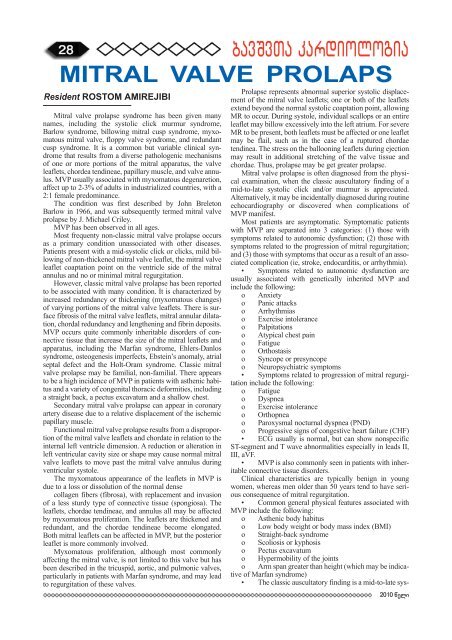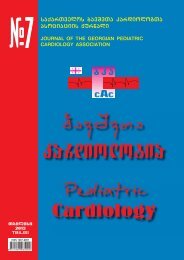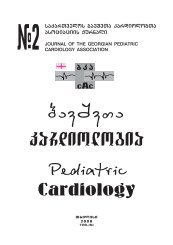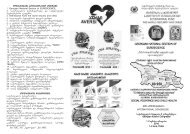Create successful ePaper yourself
Turn your PDF publications into a flip-book with our unique Google optimized e-Paper software.
28 ,fdidsf rfhlbjkjubf<br />
MITRAL VALVE PROLAPS<br />
Resident ROSTOM AMIREJIBI<br />
Mitral valve prolapse syndrome has been given many<br />
names, including the systolic click murmur syndrome,<br />
Barlow syndrome, billowing mitral cusp syndrome, myxomatous<br />
mitral valve, floppy valve syndrome, and redundant<br />
cusp syndrome. It is a common but variable clinical syndrome<br />
that results from a diverse pathologenic mechanisms<br />
of one or more portions of the mitral apparatus, the valve<br />
leaflets, chordea tendineae, papillary muscle, and valve annulus.<br />
MVP usually associated with myxomatous degenaretion,<br />
affect up to 2-3% of adults in industrialized countries, with a<br />
2:1 female predominance.<br />
The condition was first described by John Breleton<br />
Barlow in 1966, and was subsequently termed mitral valve<br />
prolapse by J. Michael Criley.<br />
MVP has been observed in all ages.<br />
Most frequenty non-classic mitral valve prolapse occurs<br />
as a primary condition unassociated with other diseases.<br />
Patients present with a mid-systolic click or clicks, mild billowing<br />
of non-thickened mitral valve leaflet, the mitral valve<br />
leaflet coaptation point on the ventricle side of the mitral<br />
annulus and no or minimal mitral regurgitation.<br />
However, classic mitral valve prolapse has been reported<br />
to be associated with many condition. It is characterized by<br />
increased redundancy or thickening (myxomatous changes)<br />
of varying portions of the mitral valve leaflets. There is surface<br />
fibrosis of the mitral valve leaflets, mitral annular dilatation,<br />
chordal redundancy and lengthening and fibrin deposits.<br />
MVP occurs quite commonly inheritable disorders of connective<br />
tissue that increase the size of the mitral leaflets and<br />
apparatus, including the Marfan syndrome, Ehlers-Danlos<br />
syndrome, osteogenesis imperfects, Ebstein’s anomaly, atrial<br />
septal defect and the Holt-Oram syndrome. Classic mitral<br />
valve prolapse may be familial, non-familial. There appears<br />
to be a high incidence of MVP in patients with asthenic habitus<br />
and a variety of congenital thoracic deformities, including<br />
a straight back, a pectus excavatum and a shallow chest.<br />
Secondary mitral valve prolapse can appear in coronary<br />
artery disease due to a relative displacement of the ischemic<br />
papillary muscle.<br />
Functional mitral valve prolapse results from a disproportion<br />
of the mitral valve leaflets and chordate in relation to the<br />
internal left ventricle dimension. A reduction or alteration in<br />
left ventricular cavity size or shape may cause normal mitral<br />
valve leaflets to move past the mitral valve annulus during<br />
ventricular systole.<br />
The myxomatous appearance of the leaflets in MVP is<br />
due to a loss or dissolution of the normal dense<br />
collagen fibers (fibrosa), with replacement and invasion<br />
of a less sturdy type of connective tissue (spongiosa). The<br />
leaflets, chordae tendineae, and annulus all may be affected<br />
by myxomatous proliferation. The leaflets are thickened and<br />
redundant, and the chordae tendineae become elongated.<br />
Both mitral leaflets can be affected in MVP, but the posterior<br />
leaflet is more commonly involved.<br />
Myxomatous proliferation, although most commonly<br />
affecting the mitral valve, is not limited to this valve but has<br />
been described in the tricuspid, aortic, and pulmonic valves,<br />
particularly in patients with Marfan syndrome, and may lead<br />
to regurgitation of these valves.<br />
Prolapse represents abnormal superior systolic displacement<br />
of the mitral valve leaflets; one or both of the leaflets<br />
extend beyond the normal systolic coaptation point, allowing<br />
MR to occur. During systole, individual scallops or an entire<br />
leaflet may billow excessively into the left atrium. For severe<br />
MR to be present, both leaflets must be affected or one leaflet<br />
may be flail, such as in the case of a ruptured chordae<br />
tendinea. The stress on the ballooning leaflets during ejection<br />
may result in additional stretching of the valve tissue and<br />
chordae. Thus, prolapse may be get greater prolapse.<br />
Mitral valve prolapse is often diagnosed from the physical<br />
examination, when the classic auscultatory finding of a<br />
mid-to-late systolic click and/or murmur is appreciated.<br />
Alternatively, it may be incidentally diagnosed during routine<br />
echocardiography or discovered when complications of<br />
MVP manifest.<br />
Most patients are asymptomatic. Symptomatic patients<br />
with MVP are separated into 3 categories: (1) those with<br />
symptoms related to autonomic dysfunction; (2) those with<br />
symptoms related to the progression of mitral regurgitation;<br />
and (3) those with symptoms that occur as a result of an associated<br />
complication (ie, stroke, endocarditis, or arrhythmia).<br />
• Symptoms related to autonomic dysfunction are<br />
usually associated with genetically inherited MVP and<br />
include the following:<br />
o Anxiety<br />
o Panic attacks<br />
o Arrhythmias<br />
o Exercise intolerance<br />
o Palpitations<br />
o Atypical chest pain<br />
o Fatigue<br />
o Orthostasis<br />
o Syncope or presyncope<br />
o Neuropsychiatric symptoms<br />
• Symptoms related to progression of mitral regurgitation<br />
include the following:<br />
o Fatigue<br />
o Dyspnea<br />
o Exercise intolerance<br />
o Orthopnea<br />
o Paroxysmal nocturnal dyspnea (PND)<br />
o Progressive signs of congestive heart failure (CHF)<br />
• ECG usually is normal, but can show nonspecific<br />
ST-segment and T wave abnormalities especially in leads II,<br />
III, aVF.<br />
• MVP is also commonly seen in patients with inheritable<br />
connective tissue disorders.<br />
Clinical characteristics are typically benign in young<br />
women, whereas men older than 50 years tend to have serious<br />
consequence of mitral regurgitation.<br />
• Common general physical features associated with<br />
MVP include the following:<br />
o Asthenic body habitus<br />
o Low body weight or body mass index (BMI)<br />
o Straight-back syndrome<br />
o Scoliosis or kyphosis<br />
o Pectus excavatum<br />
o Hypermobility of the joints<br />
o Arm span greater than height (which may be indicative<br />
of Marfan syndrome)<br />
• The classic auscultatory finding is a mid-to-late sys-<br />
<strong>2010</strong> weli
















